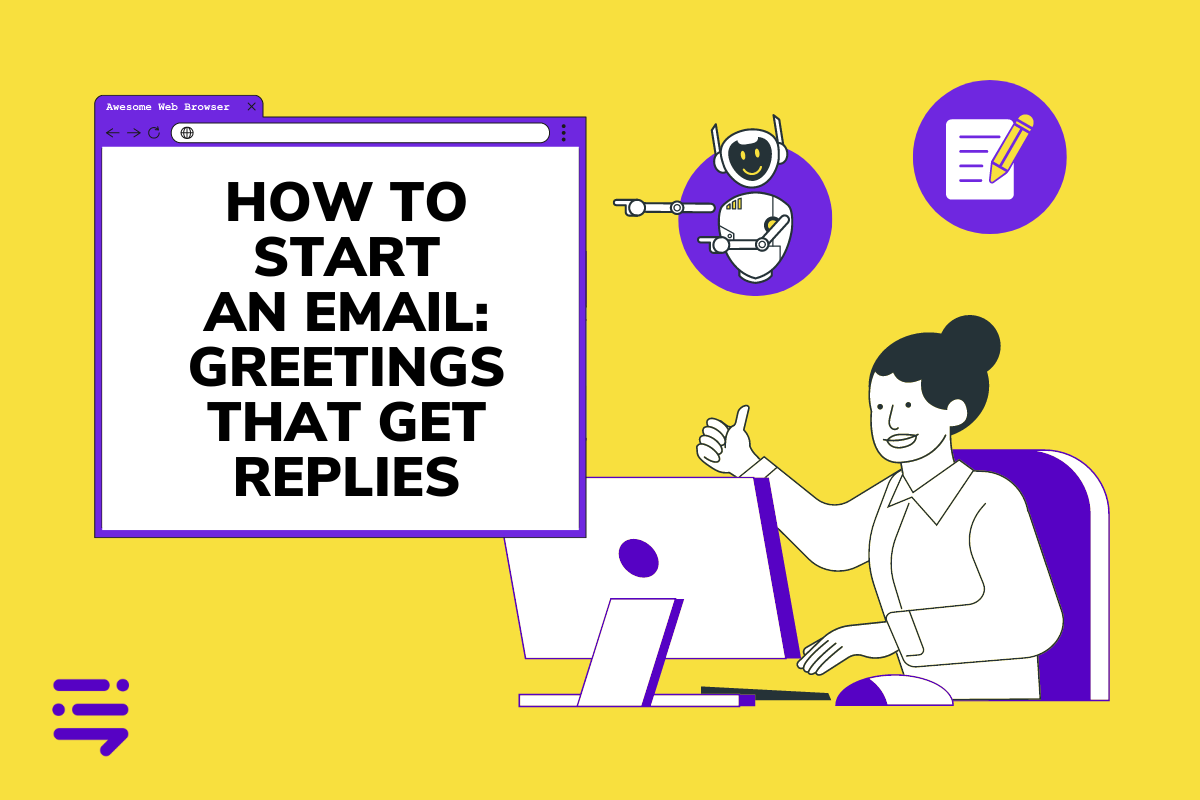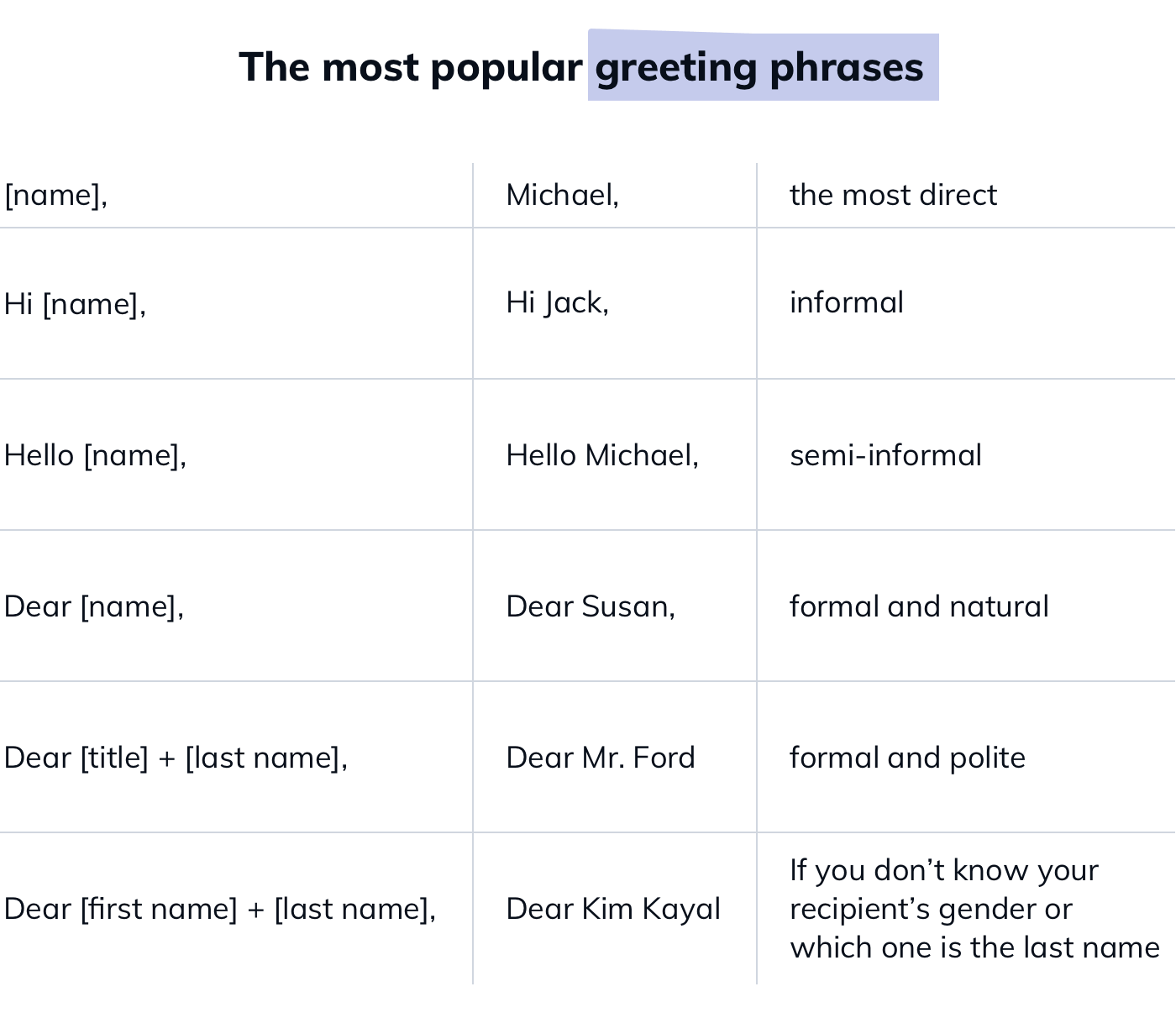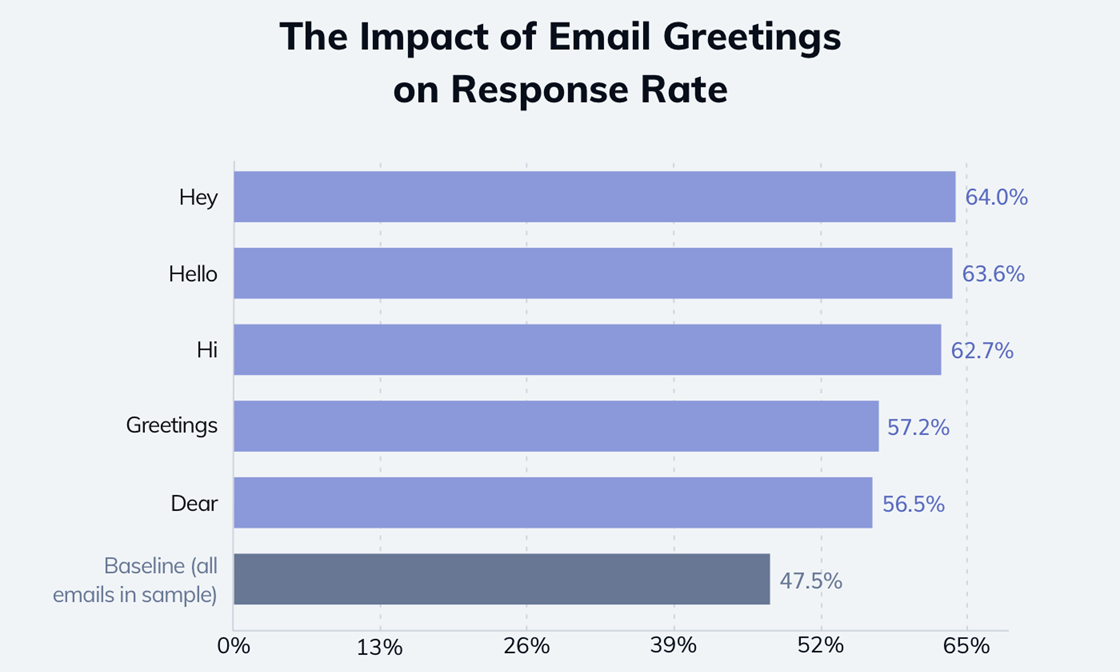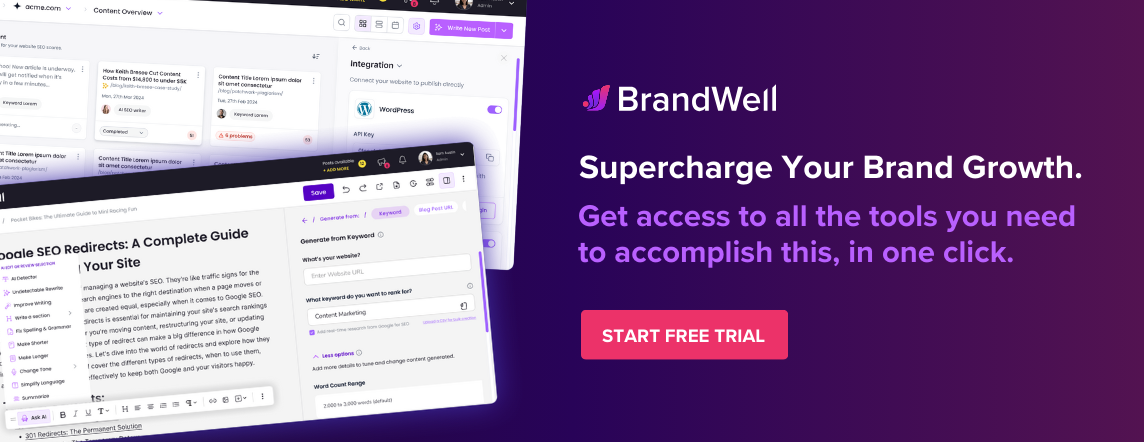Discover top guides, trends, tips and expertise from AIO Writers
How to Start an Email: Greetings That Get Replies
Julia McCoy
Monday, 29th Apr 2024
You’ve got a potential prospect that you’re ready to pitch, and you know that email opening lines can make or break your chances of getting a response. Let me show you the ropes of how to start an email, detail by detail.
Whether you’re writing a formal email to your boss, a casual message to a coworker, or a follow-up to a potential client, I’ve got you covered.
So, let’s dive in and discover how to start an email that gets results.
Table Of Contents:
- Formal Email Greetings for Professional Communication
- Casual Email Greetings for Colleagues and Acquaintances
- How to Address Multiple Recipients in Professional Emails
- How to Start a Follow-up Email
- How to Write the Perfect Email Opening Line
- Building Strong Relationships Through Email Communication
- Common Mistakes to Avoid in Email Greetings
- FAQs: How to Start an Email
- Conclusion
Formal Email Greetings for Professional Communication
When it comes to starting a formal email, choosing the right greeting is crucial. It sets the tone for the entire message and can make or break your chances of getting a response.
In a 2020 report, 73% of people said that email is their preferred communication method at work. So, getting your email greetings right is essential, especially in a professional context.
Here are some popular opening greetings to start a professional email.
Dear Sir/Madam
“Dear Sir/Madam” is a classic formal email greeting that’s been around for ages. It’s a safe bet for email salutations when you don’t know the recipient’s name or gender. But, let’s be real, it can come across as a bit dull and impersonal.
I once received an email that started with “Dear Sir/Madam,” followed by “I hope this email finds you well.” The problem? The sender knew my name and had even met me in person before. Talk about a missed opportunity to connect on a more personal level.
To Whom It May Concern
“To Whom It May Concern” is another formal email greeting that’s often used when you don’t know the recipient’s name. It’s a bit more formal than “Dear Sir/Madam,” but it can still feel a bit distant.
I remember sending out a job application years ago and starting my cover letter with “To Whom It May Concern.” Looking back, I wish I had taken the time to find out the hiring manager’s name. It would have shown that I was truly interested in the position and the company.
Dear [Job Title]
When you know the recipient’s job title but not their name, “Dear [Job Title]” can be a good option for a formal email.
For example, “Dear Hiring Manager” or “Dear Customer Service Representative.”
I once received an email from a job applicant that started with “Dear Content Marketing Manager.” It immediately caught my attention because it showed that the applicant had done their research and knew exactly who they were reaching out to.
When you’re sending a formal email to an unknown recipient, it’s important to err on the side of caution and use a more formal greeting like “Dear Sir/Madam” or “To Whom It May Concern.”
I know it can be tempting to skip the greeting altogether and jump right into your message, but trust me, it’s not worth it. A proper greeting shows that you respect the recipient’s time and are willing to put in the effort to make a good impression.
Casual Email Greetings for Colleagues and Acquaintances
When you’re emailing colleagues or acquaintances, you have a bit more leeway when it comes to greetings compared to the rigid nature of a professional email. You can ditch the formalities and opt for something a bit more casual and friendly.
Hi [Name]
“Hi [Name]” is my go-to casual email greeting. It’s simple, friendly, and gets the job done. Plus, it’s hard to go wrong with a classic like this.
I use “Hi [Name]” all the time when emailing my coworkers or clients that I’ve built a rapport with. It’s a great way to start an email on a positive note and show that you value the relationship.
Hello [Name]
“Hello [Name]” is another casual email greeting that’s a bit more formal than “Hi,” but still friendly and approachable. It’s a good choice when you want to strike a balance between casual and professional.
I often use “Hello [Name]” when emailing someone for the first time or when I’m not quite sure how casual I can be. It’s a safe bet that shows you’re friendly, but still respectful of the recipient’s time and attention.
Hey [Name]
“Hey [Name]” is about as casual as it gets when it comes to email greetings. It’s the kind of greeting you’d use with your closest colleagues or friends.
I reserve “Hey [Name]” for my work besties or clients that I’ve built a really strong relationship with. It’s a great way to show that you’re comfortable with the person and value the friendship you’ve built.
Good Morning/Afternoon/Evening
“Good Morning,” “Good Afternoon,” or “Good Evening” can be a nice way to add a personal touch to your casual email greetings. It shows that you’re taking a moment to wish the recipient well.
I love using these greetings when I’m emailing someone in a different time zone or when I want to add a bit of warmth to my message. It’s a small thing, but it can make a big difference in how your email is received.

How to Address Multiple Recipients in Professional Emails
When you’re sending an email to a group, it’s important to use a greeting that acknowledges everyone. Trust me, I’ve made the mistake of leaving someone out before and it’s not a good look.
You want to make sure that each person feels included and valued. That’s where using a collective term comes in handy.
Dear [Team/Department/Group]
One of my go-to greetings for multiple recipients is “Dear [Team/Department/Group].” It’s a catch-all that ensures you’re not leaving anyone out.
For example, “Dear Marketing Team” or “Dear Sales Department.”
This works well when you’re addressing a specific group within a company or organization. It shows that you’ve taken the time to think about who you’re reaching out to and that you value their input as a collective.
Hello Everyone
Another option is a simple “Hello Everyone.” This is a friendly, casual way to greet multiple recipients without being overly formal.
I like to use this one when I’m emailing a group of colleagues or team members that I work with regularly. It sets a warm, collaborative tone right off the bat.
Greetings All
If you want to strike a balance between casual and professional, “Greetings All” is a solid choice. It’s a bit more formal than “Hello Everyone,” but not as boring as “Dear Sir/Madam.”
This one works well when you’re greeting multiple recipients that you may not know very well, but still want to keep things friendly and approachable.
The key with any of these greetings is to make sure you’re being inclusive and respectful of everyone on the email chain. A little thought goes a long way in building strong working relationships.

How to Start a Follow-up Email
Following up is a crucial part of any professional relationship, whether you’re trying to land a job, close a deal, or just stay in touch with a colleague. But, starting a follow-up email can be tricky. You want to be persistent, but not pushy. Friendly, but not overly familiar.
Thank You for Your [Previous Interaction]
When you’re following up after a previous interaction, whether it was a phone call, meeting, or email exchange, starting with a thank you is always a good idea. It shows that you value the recipient’s time and are grateful for the opportunity to connect.
For example:
“Thank you for taking the time to speak with me yesterday about the marketing manager position. I enjoyed learning more about the role and the company’s goals for the coming year.”
Following Up on Our [Previous Topic]
If you’re following up on a specific topic or project, it’s helpful to reference it in your email greeting. This helps to jog the recipient’s memory and sets the stage for the rest of your message.
For example:
“I wanted to follow up on last week’s conversation about the new product launch. I’ve been thinking about some ideas for the marketing campaign and would love to get your feedback.”
Just Wanted to Check In
Sometimes, you just need to check in and see how things are going. A simple “Just wanted to check in” can be a good way to start your email in these follow-up emails.
For example:
“Just wanted to check in and see how things are going with the new software implementation. Let me know if there’s anything I can do to help.”
How to Write the Perfect Email Opening Line
Your email opening lines are your first chance to grab the recipient’s attention and make a good impression. They’re the hook that draws people in and makes them want to keep reading.
A few tips on how to kickstart your professional email:
Mention a Recent Event or Accomplishment
If you know of a recent event or accomplishment in the recipient’s life, mentioning it in your email opening lines can be a great way to build rapport and show that you’re paying attention.
For example:
“Congrats on the successful product launch last week. I saw the news coverage and was really impressed with the innovative features you introduced.”
Ask a Thought-Provoking Question
Asking a thought-provoking question in your email opening lines can be a great way to engage the recipient and get them thinking about your message.
For example:
“Have you ever wondered why so many marketing campaigns fail to connect with their target audience? I’ve been doing some research on the topic and would love to share my findings with you.”
Express Gratitude or Appreciation
Expressing gratitude or appreciation in your email opening line is a simple but effective way to build goodwill and show that you value the recipient’s time and attention.
For example:
“I just wanted to take a moment to thank you for your guidance and support over the past few months. Your insights have been invaluable in helping me navigate my new role.”
Crafting the perfect email opening line takes practice and a bit of creativity. But, by focusing on building rapport, engaging the recipient, and expressing gratitude, you’ll be well on your way to writing emails that get noticed and get results.
Building Strong Relationships Through Email Communication
Email is such a huge part of our professional lives these days. It’s not just about exchanging information – it’s a tool for building and nurturing relationships.
But how do you foster those connections through a screen? I’ve found that the key is in the little things, like your email greetings.
Personalize Your Greetings
Nothing says “I value our relationship” like a personalized greeting.
Instead of a generic “Hello,” try “Hi [First Name]” or “Good morning, [First Name].”
Using the recipient’s name shows that you see them as an individual, not just another email address in your inbox. It’s a small touch that can make a big difference in building strong relationships.
Show Genuine Interest
Another way to build strong connections through business emails is by showing genuine interest in the other person. Ask about their recent projects, share an article you think they’d enjoy, or mention something you have in common.
When you take the time to learn about your colleagues and clients as people, not just professional contacts, you lay the groundwork for strong relationships built on trust and mutual respect.
Maintain a Friendly Yet Professional Tone
It’s a delicate balance, but striking the right tone in your business email is crucial. You want to be warm and approachable, but also professional and respectful.
Aim for a conversational style that still upholds the boundaries of your working relationship. A friendly greeting, a bit of small talk, and a clear, concise message can go a long way in eliciting positive responses and building rapport.
Remember, every email is an opportunity to strengthen your professional relationships. Put thought into your greetings, show interest, and strike that friendly yet professional balance.
Common Mistakes to Avoid in Email Greetings
We’ve all been there – you fire off an email, hit send, and then realize you’ve made a cringe-worthy mistake in your greeting. It happens to the best of us.
But the good news is, most of these faux pas are easily avoidable with a little forethought and attention to detail.
Steer Clear of Overly Formal Salutations
Unless you’re writing to the Queen of England, it’s best to avoid overly formal salutations like “Dear Sir/Madam” or “To Whom It May Concern.” These can come across as cold and impersonal, especially if you’re addressing an unknown person.
Instead, opt for a more neutral greeting like “Hello” or “Good morning/afternoon.”
If you do know the recipient’s name, use it.
Double-Check Recipient Names
There’s nothing quite like the sinking feeling of realizing you’ve misspelled someone’s name in an email greeting. It’s a surefire way to start on the wrong foot and can make you seem careless or disrespectful.
Always, always double-check the spelling of your recipient’s name before hitting send. If you’re unsure, do a quick Google search or check their email signature. Taking that extra moment can save you a lot of embarrassment down the line.
Avoid Gendered Language
In today’s diverse workplace, it’s important to be mindful of gendered language in your email greetings. Salutations like “Dear Sir” or “Gentlemen” can be seen as exclusionary and may not accurately reflect your recipient’s identity.
Play it safe by using gender-neutral language like “Dear [Job Title],” “Hello [Team/Department],” or simply “Hi there.” This ensures you’re being respectful and inclusive of all your colleagues and clients.
The bottom line? Put yourself in your recipient’s shoes.
Would you want to be addressed as “Dear Sir/Madam” or have your name misspelled?
Probably not.
By steering clear of these common mistakes, you’ll set a tone of professionalism and respect in all your email communications.
FAQs: How to Start an Email
How do you professionally start an email?
Begin with “Dear [Name]” or “Hello [Name]” for a touch of professionalism that feels both warm and respectful.
What is a good sentence to start an email?
“I hope this message finds you well” sets a considerate tone, making it a solid opener.
How do I start an email nicely?
Kick things off with “Hi [Name],” – it’s friendly without crossing into overly casual territory.
What is the best greeting to start an email?
“Good Morning/Afternoon/Evening [Name]” adapts to any time zone, adding a personalized yet professional vibe right away.
Conclusion
Learning how to write an email with the right greeting can make all the difference in getting a response. By following these tips, you’ll be able to craft emails that capture your recipient’s attention and build strong relationships.
Remember, the key to writing professional emails is to tailor your greeting to your audience and the purpose of your email. Whether you’re going for a formal or casual tone, always aim for clarity, professionalism, and a touch of personality.
Need help starting an email? Ask AIMEE to do it for you! BrandWell’s super smart chatbot can help you write any type of email — from formal to casual to personalized.

UNLOCK YOUR POTENTIAL
Long Headline that highlights Value Proposition of Lead Magnet
Grab a front row seat to our video masterclasses, interviews, case studies, tutorials, and guides.



